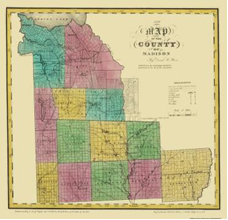Early Madison County History

Location in the State of New York
The history of Madison County prior to its erection has been recounted under the chapter dealing with Chenango County, with which it was joined. The Madison region was relatively free from early Indian difficulties, for the aborigines received the first settlers as friends with whom they were glad to share their hunting grounds and lowland fields.
Not until persuaded by white men that they were being mistreated did they join the former in raids upon their erstwhile friends. There was little attempt to settle this district until Revolutionary times and the Indian lands were then purchased by the authorities of the State, distributed to the soldiers, or sold to speculators who induced many to migrate and develop large areas which had hitherto been neglected or unknown.
Madison was a part of the great reserved Indian domain extending from its eastern boundaries indefinitely west. One of the first results of peace with England was the extinction of the Indian title to this great area. The county is on parts of three tracts surveyed from 1775 to 1795, known as the Military Tract, the Tuscarora Purchase and the Gore, a strip overlooked in the laying out of the lines of the first two. There are, of course, many minor divisions and patents in Madison to which even today land titles are traced.
Chenango County, set off from Herkimer and Tioga counties in 1798, included Madison, which became a separate division March 21, 1806. The latter was enlarged thirty years later by the annexation of part of the town of Stockbridge Iying east of Oneida Creek. It took its title from President James Madison. On its formation there were only five civil divisions: Brookfield, Cazenovia, DeRuyter, Hamilton and Sullivan towns. From the territory of these five have nine others been erected, five during the year following the organization of the county. The names and 1920 population of these towns are: Brookfield, 2,092; Cazenovia, 3,343; DeRuyter, 1,141; Eaton, 2,223; Fenner, 780; Georgetown, 854; Hamilton, 3,354; Lebanon, 940; Lenox, 5,536; Lincoln, 821; Madison, 1,629; Nelson, 1,099; Smithfield, 767; Stockbridge, 1,413; and Sullivan, 3,002.
The county is one of the central ones of the State, bounded on the north by Oneida County; on the east by Oneida and Otsego; on the south by Chenango; and on the west by Onondaga and Cortland counties. It has an area of 650 square miles and a population in 1920 of 39,535, being one of the few rural counties which have not lost population to any extent in the last fifty years. It has a great variety of surface from the swamp lands near Lake Oneida on the north to the rich vales in the south. The central part is on the water shed of many of the streams, some going north to the lake, while the others make their way to the Susquehanna. The land is not mountainous but generally elevated. The principal stream of Madison is the Chittenango, which not only flows through a region of marked beauty, but has hydraulic possibilities which have never been fully utilized, although the site of many ancient mills. In one of its, reaches of eight miles it descends 740 feet, one of the falls being 134 feet. Besides Oneida Lake, the county has a gem in Cazenovia, or as it is sometimes called, Owahgena Lake, which has become one of the best known summer resorts of the county.
The variety of surface has made for a variety of uses made of the land. The heavy forests of the pioneer days have well-nigh disappeared, but in their place have come large cultivated areas producing most of the staples possible to the central section of New York. The grains, hay and milk now lead among the products, but this has, from the first, proven its fitness for apple growing which has taken a new lease on life during the last twenty-five years. Hops used to be a banner crop, but were finding the competition of the far west severe and was on the wane before the Volstead law gave it the fatal blow. Cheese and butter making was the main industry of Madison until it proved more profitable to ship the milk in the natural state or turn it over to condensers. Change has taken place in the agricultural methods and crops, and it is well for the visitor to remember, when he is passing through some beautiful section, and sees what to him are waste fields, ruined mills and neglected farms, that it is due to no fault of the region, but rather to the advance or change which is inherent in any business which is vital and grows.



